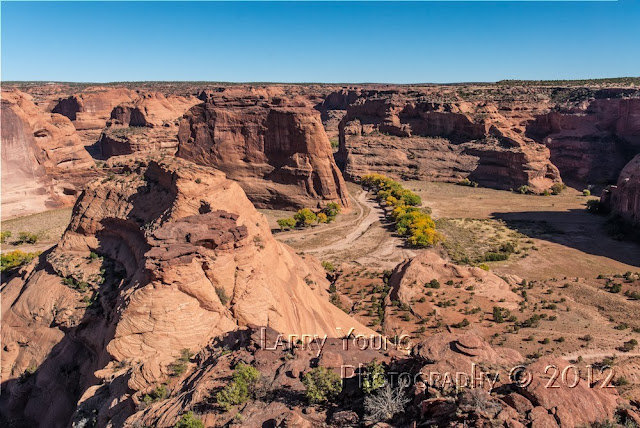Archeological evidence shows that people have lived in the canyons for nearly 5000 years. The first people to come to the valley were called Archaic. They were the hunters and gathers. Canyon de Chelly provided an abundance of small and large animals for food. About 2500 years ago, a group of people came to the canyons called Basketmakers. These people had additional skills like weaving and farming. Basketmakers rock drawings show a society of extended families growing and storing food and engaging in religious activities. After the Basketmakers, (about 1250 years ago) a group of people called the Pueblo Indians came to the canyons. The Basketmakers lived in dispersed hamlets; but the Puebloan people developed a new kind of settlements called villages. Why, is unclear, but it could have been for defense purposes. These people grew Turkeys for food and harvested cotton for weaving. Puebloan life ended about 700 years ago and these people left to establish villages along the Little Colorado and the southern tip of the Black Mesa, and later to become known as the Hopi. The Navajos now occupy the canyons and still farm them today. They grow cotton, corn, fruit, sheep, and other crops.
Although Canyon de Chelly is very beautiful, it is scared with a legacy of death and destruction brought on by the U.S. Military. In 1863 Kit Carson was commissioned as a colonel and discharged with the duty to massacre every Navajo he could find. In the winter of 1864 kit Carson entered the eastern end of the canyon and pushed the Navajos toward the mouth of the canyon. Killing women, children, men, and animals, destroying all crops, Hogans, and anything else that the Navajos held dear. The massacre was immense. Later in the spring, he came back again and killed or took capture anything that was left. Any Navajos that were taken prisoner were forced to march over 300 miles to Fort Sumner in New Mexico territory. Scores perished from thirst, hunger, or fatigue. Many of those that survived the “Long Walk” later died at Fort Sumner because of poor food, shelter, and disease. In 1868 the few remaining survivors were released and allowed to return to the canyon a rebuild their lives.
We were very fortunate to hire a Navajo guide who actually lived and worked the canyon. His name is Ben. He is an older gentleman about 70 years old. He is a 4th generation Navajo farmer of the Canyon Del Muerto. In fact, he even took us up to the property he farms with his siblings. This was one on the most interesting 3 hours I have every spent with an individual. Because it was just my wife and I, were we able to get some very personal and insightful information. He told many fascinating stories of crowing up in the canyon. One was of his mother weaving cotton to make rugs to sell at the trading post in Chinle. If he was a good boy and did not play in the Anasazi ruins behind their home, and did his chores, he was rewarded with the opportunity to make the trip into Chinle and maybe get some chocolate. Mind you, the trip to Chinle was over 5 hours one way. Now it takes about 30 minutes by car. Ben not only farms his past generations land, but also conducts tours of the canyons. In a day he makes 3-5 trips in and out of the canyon. Also keep in mind, this is no easy task. He is a very skilful sand driver. It is inconceivable to me how he can spend so much time driving in that sand and not get stuck. I guess it’s like a bird flying. Second nature for the bird, but don’t you try it. I asked how do you keep people out without guides, because anyone can just drive in. He said it’s not really an issue because they never get more than a quarter of a mile before getting stuck. He told of a couple in a 4 wheel drive pickup that was stuck in the morning when he took his first tour. They were trying to dig their way out. When he came back three hours later, they had gotten out and made it about 100 yards farther, but were stuck again. On his second tour of the day, when he went by they were stuck again. Three hours later he found them trying to get out of the canyon, but stuck again. He said they never made it more than ¼ mile into the canyon. They had spent the whole day and only got ¼ mile.
 |
| White House Ruins |
 |
| Spider Rock |
 |
| Ruins Behind Ben's Farm |
 |
| Pictographs |
 |
| Kiva in Center |
 |
| The Grainery is on the Left |
 |
| White House Ruins |
 |
| Lower White House Ruins |
 |
| Some of Ben's Farmland on the Left |
 |
| Our Campground |





















No comments:
Post a Comment